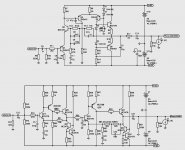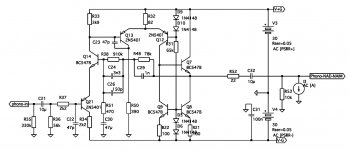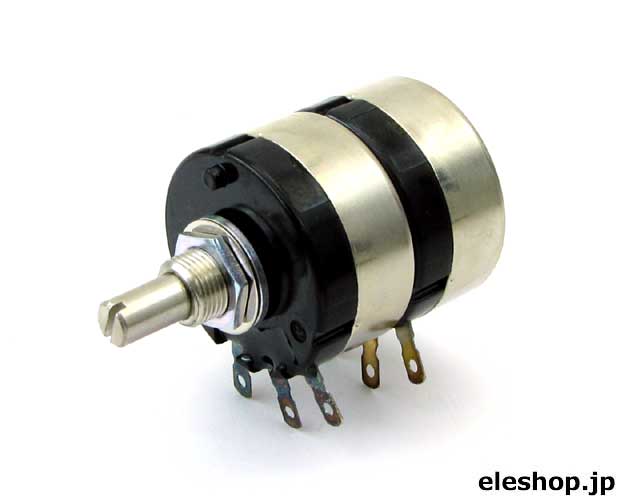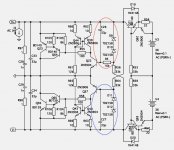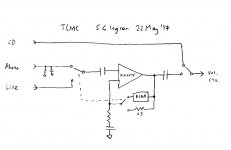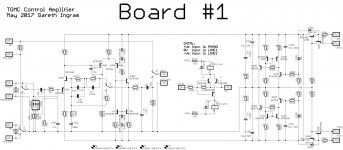I popped into the PartsConnexion webstore to look at volume pots. Here's a couple of options for smoothly variable potentiometers and a couple of options for stepped attenuators.
Pots:
a) Alpha 10k ohm LINEAR. Cheap as chips. Would buy several, check for matching at low level, add law-faked resistor.
b) TDK 10k ohm LOG. About $40 so better be well-matched out of the gate and apparently they have that reputation.
c) Khozmo 10k ohm shunt-style is apparently a make-before-break (I had wrong info before) and offers 48 steps so this should work nice. About $180.
d) DACT 10k ohm, only 23 steps which is not attractive to me. About $220.

Member
Joined 2009
Paid Member
If I can reduce the zener noise with a simple change it becomes more or less something for nothing. Always nice to learn. What I can't figure out is how he did the Spice simulation - I've used the '.noise' command infrequently. Actually, I don't know much about noise analysis. I might have once been a scientist but my PhD was about ion energy distributions in low pressure ionized gases - although I did make something very close to the mythical p-type Pentode in the process. Many years later I made a vertical hot electron transistor with a 2-dimensional electron gas control electrode. But ask me about noise in electrical circuits and I'm not quite there yet. Johnson noise is one thing, zener avalanche noise OK, but I have no feel for the tradeoffs. A simple RC filter to the base of the first transistor is, on reflection, a possible improvement without adding more than 1 part (re-purposing the original capacitor) and the Johnson noise of the R is shunted to the rail.
Mark - can you post your .asc file ?
Mark - can you post your .asc file ?
When you put it like that you'd have to sit there fiddling with the darn thing to get your money worth !!!! I kinda like the Khozmo, they look fancy all painted up like that and I wouldn't object to the cost if the volume control were the bottleneck in my system. I'm not sure it is though. For inverse-snobery value then the Alpha is the way to go. I'd like to try a PEC but they're too expensive relative to the build quality from what I've read.Oh I'd go for option d) just for the sheer audacity of it!!! You can proudly boast to your guests that it cost you $9.57 per step.

Last edited:
I don't like to reward laziness; that encourages behavior I don't endorse.
How about this: after you have convened your group of circuit consultants and worked together on the problem for a while, after you have posted a few examples of ideas your group has tried out in simulation: (experiment, results), after you have posted links to other diyAudio threads you have studied which include the words Zener and Noise in the title, ask whether anybody else has any further ideas for additional improvements (at low cost).
How about this: after you have convened your group of circuit consultants and worked together on the problem for a while, after you have posted a few examples of ideas your group has tried out in simulation: (experiment, results), after you have posted links to other diyAudio threads you have studied which include the words Zener and Noise in the title, ask whether anybody else has any further ideas for additional improvements (at low cost).
Member
Joined 2009
Paid Member
I don't like to reward laziness; that encourages behavior I don't endorse.
...your 'bedside manner' is just not at the same level as your technical expertise - that's the way it is sometimes.
p.s. The other guys, if they don't mind, I prefer to refer to as my friends, not 'consultants'
Last edited:
Member
Joined 2009
Paid Member
If the buffer is required could it be converted to 3180+318 uS active and 75 uS passive? Naturally listen to both.
Hi Nigel,
I looked into this a bit more and it seems to be a well-regarded combination. The Naim '322' phono takes this approach using 10 transistors. My NAD based phono with buffer included uses 9 transistors and if using this as a crude indication of complexity goes the two approaches are similar.
If I try to add the 75us as a passive before the buffer in my NAD based design then we have to lower the gain of the preceding gain stage to match up and this loses us x10 in signal output compared with the all-active. That gain can be made-up with the NAIM gain stage I'm including in the box but then we have in total a lot more in the signal path - will this approach still be an improvement in perceived sound over the all-active design I've posted ?
Will the NAIM '322' phono be subjectively better ?
We are the circuit consultants !
I remember there was quite a bit of chat on the Salas thread about this. In the end, he said that listening tests showed the Zener was not the limiting factor (vinyl surface noise was very dominant). But he uses larger caps across the zener than I've indicated there. Even a quick look on Digikey shows that I can go with a 330uF in this position, same size footprint, 50V rating.
Zener diodes become noiser with higher voltage ratings - I have not followed Salas' work however you also have dual supplies so it is not clear his experience with vinyl input necessarily applies here - CD has superior noise performance so the possibility of any circuit noise intrusion with that medium should be avoided.
An off the wall thought about dispensing with the zener capacitor arrangement is to replace these parts with a resistor and to delete the 750R resistor biasing to earth.
Replace that with a transistor - 2N3904 in the top half of your circuit. Bias the base to earth with a 1N4148 with a parallel capacitor for smoothing and derive the supply source from V10 or equivalent via a dropping resistor to switch the 2N3904 on. A rough figure for this was 18k with 10k for the zener capacitor replacement.
Member
Joined 2009
Paid Member
can you do a little drawing of this ?An off the wall thought about dispensing with the zener capacitor arrangement ...
Member
Joined 2009
Paid Member
A tale of two phono amps...
I simulated the NAIM '322' phono - looks just fine (perhaps some tweaks to the RIAA values) and the Zout is good as-is for this project. Along with the gain stage I have using this phono would make it an all-NAIM design
I also went back and revisited the NAD3020. I 'upgraded' it by transplanting the output stage from the NAD3080 posted earlier. I retained the high-impedance feedback network for now (potentially, the NAD3080 lower impedance feedback network has lower noise). It also looks just fine, in fact it looks very nice, also with low Zout. It's an all-active design unlike the NAIM but is also a fair bit simpler.
eeny meeny miny moe.....
I simulated the NAIM '322' phono - looks just fine (perhaps some tweaks to the RIAA values) and the Zout is good as-is for this project. Along with the gain stage I have using this phono would make it an all-NAIM design
I also went back and revisited the NAD3020. I 'upgraded' it by transplanting the output stage from the NAD3080 posted earlier. I retained the high-impedance feedback network for now (potentially, the NAD3080 lower impedance feedback network has lower noise). It also looks just fine, in fact it looks very nice, also with low Zout. It's an all-active design unlike the NAIM but is also a fair bit simpler.
eeny meeny miny moe.....
Attachments
Member
Joined 2009
Paid Member
And just for fun.....
Putting a bit of the NAIM phono output stage onto the NAD3020. A kind of mix, which keeps it single ended and no bootstrap hanging off the output like the NAD3080. Of course, Zout is just fine but it's all active, no passive 75us for Nigel. Nevertheless, I think I like this one
Putting a bit of the NAIM phono output stage onto the NAD3020. A kind of mix, which keeps it single ended and no bootstrap hanging off the output like the NAD3080. Of course, Zout is just fine but it's all active, no passive 75us for Nigel. Nevertheless, I think I like this one

Attachments
I think MarkJ is referring to increasing the R of the RC filter created when you add that capacitor.
The R in that RC is the dynamic impedance of the Zener. It might be somewhere between 1r and 10r depending on Iz and type.
If you feed voltage & current into the Zener, then add and RC filter after that you can adjust the R & C for more filtering.
Then tap off the required voltage reference from the output of the filter.
As I see it that adds one resistor. MarkJ must have something else in mind.
I need more clues.
The R in that RC is the dynamic impedance of the Zener. It might be somewhere between 1r and 10r depending on Iz and type.
If you feed voltage & current into the Zener, then add and RC filter after that you can adjust the R & C for more filtering.
Then tap off the required voltage reference from the output of the filter.
As I see it that adds one resistor. MarkJ must have something else in mind.
I need more clues.
Last edited:
This is the type of passive then active phono I use ( plus 2uS passive output if into older amps at it's output ). The NAD might need a bit of thinking to do the same. Having measured the overload margin I see no obvious defect and because the HF is rolled off first the 3180/318 uS has a more comfortable life. Also one can provide 25 to 100 uS without any complex maths, this is a very big deal in a system without tone controls. I don't use 7950 uS as some do. More so a 3rd order 20 Hz filter. I use PA drive units on an OB ( 15 inch + 12 inch ). They don't give a damn about warps, this says it can be made to work. My LF is 6Hz - 3 dB amplifier and 40Hz flat and 30 Hz - 12 dB. I tried some SB Acoustics 6 inc drivers on the same size OB, They worked 60 % of the time. Even BBC broadcasts of 78's troubled them. Real shame as they sounded very good. A port loaded speaker shares some of the OB problem's. I have 15 in and 12 inch units with Qts at 1.2 and 0.5. LF is 6Hz and 20 Hz.
This style of passive/active circuit was recomended to me by John Dawson of Arcam in 1977 when I bought an A60 Sno 301 from him ( £92.59 trade and my very first cheque, That's 129.95 -25%-5% payment up front ). I use Garrard 301/401 so it was meant to be. The A60 is a great amp with no great defect. My friend Terry was going to do up Julians 401, alas Julian died soon after. Terry was also going to lend one to Ex PM Edward Heath, same outcome! I think that was also Salisbury. Blame Terry I think.
Active/passive RIAA online calculator | Crazy Audio
This style of passive/active circuit was recomended to me by John Dawson of Arcam in 1977 when I bought an A60 Sno 301 from him ( £92.59 trade and my very first cheque, That's 129.95 -25%-5% payment up front ). I use Garrard 301/401 so it was meant to be. The A60 is a great amp with no great defect. My friend Terry was going to do up Julians 401, alas Julian died soon after. Terry was also going to lend one to Ex PM Edward Heath, same outcome! I think that was also Salisbury. Blame Terry I think.
Active/passive RIAA online calculator | Crazy Audio
Member
Joined 2009
Paid Member
have you used this unit, did it perform well ?Tocos RV30YG ?[/URL]
If you feed voltage & current into the Zener, then add and RC filter after that you can adjust the R & C for more filtering.Then tap off the required voltage reference from the output of the filter. As I see it that adds one resistor.
Yes, that was my thought. A trivial change for a large gain. Attached is my interpretation, the blue oval shows the original approach, the red circle is the improved version. Obviously, capacitor values can be adjusted.
Attachments
Last edited:
Good thing it occurred to you to simulate the attenuation of zener noise, realize it could be improved many thousandfold with a trivial change, and then devise an implementation whose cost was 2 or fewer components. Congratulations!
In your opinion, how many other low-hanging fruit remain? By that I mean, places in the circuit where a small modification would produce an enormous benefit?
In your opinion, how many other low-hanging fruit remain? By that I mean, places in the circuit where a small modification would produce an enormous benefit?
Member
Joined 2009
Paid Member
Member
Joined 2009
Paid Member
The Lazy Man scheme
What if I was lazy (it'a already been suggested) and instead of making two separate amplifiers I just make one with switchable gain covering High Gain (with RIAA correction) and Low Gain (for a source that needs a 5x boost). A 'modern' CD/DAC source would need no gain. It's quite appealing I have to say.
and instead of making two separate amplifiers I just make one with switchable gain covering High Gain (with RIAA correction) and Low Gain (for a source that needs a 5x boost). A 'modern' CD/DAC source would need no gain. It's quite appealing I have to say.
Thoughts ?
What if I was lazy (it'a already been suggested)
Thoughts ?
Attachments
Last edited:
Why not leverage the combined wisdom of the entire 250,000+ members?
Start a brand new thread with a carefully chosen title and get thousands more possible contributors. Perhaps something like
Start a brand new thread with a carefully chosen title and get thousands more possible contributors. Perhaps something like
Why do preamps have a phono-amp AND a line-amp? Why not just one w/ switched (gain & FB network)?
Member
Joined 2009
Paid Member
I did my Pd.D in Surface Acoustic Wave technology
Hey, SAW's are really cool! - some v. interesting physics going on there. We need your expertise

Clive was a clever chap, but he was probably trying to save money with this combo approach. I translated the rough sketch into Eagle to see how it looks. Right now, it looks super simple although right one of the input grounds has to be permanently connected to the circuit signal ground until I add another relay to allow full isolation of all input grounds and avoid there always being two signal grounds connected together.
Because keeping them separate provides the greatest flexibility, Clive's approach is limited as we can see. Some folk like to have the line-amp after the volume control which isn't feasible with this consolidated approach. And it keeps switches out of the 'signal' in your delicate phono amp where impedances are high (there are options to reduce the feedback loop impedance considerably from what I've shown). Sometimes the phono amp and line-amp have other performance requirements that come into conflict depending on the design choices being made but in this case there are no obvious conflicts.Why do preamps have a phono-amp AND a line-amp? Why not just one w/ switched (gain & FB network)?
Attachments
Last edited:
- Status
- This old topic is closed. If you want to reopen this topic, contact a moderator using the "Report Post" button.
- Home
- Source & Line
- Analog Line Level
- TGMC - a modular control pre-amplifier
